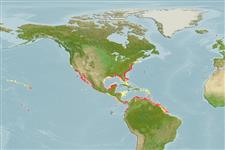Melita nitida Smith, 1873
| Native range | All suitable habitat | Point map | Year 2050 |

|
| This map was computer-generated and has not yet been reviewed. |
| Melita nitida AquaMaps Data sources: GBIF OBIS |
Google image |
No photo available for this species.
Classification / Names Tên thường gặp | Các synonym ( Các tên trùng) | CoL | ITIS | WoRMS
Malacostraca | Amphipoda | Melitidae
Environment: milieu / climate zone / Mức độ sâu / distribution range Sinh thái học
; Mức độ sâu 0 - 60 m (Tài liệu tham khảo 108754). Tropical
Distribution Các nước | Các khu vực của FAO | Các hệ sinh thái | Những lần xuất hiện | Những chỉ dẫn
Western Central Atlantic: USA.
Length at first maturity / Bộ gần gũi / Weight / Age
Chín muồi sinh dục: Lm ? range ? - ? cm
Life cycle and mating behavior Chín muồi sinh dục | Sự tái sinh sản | Đẻ trứng | Eggs | Sự sinh sản | Larvae
Main reference
Các tài liệu tham khảo | Người điều phối | Người cộng tác
Vittor, B.A. 2002 Gray's Reef benthic macroinvertebrate community assessment, April 2001. Final Report to NOAA under contract No. 50-DGNC-0-90024, NOAA NOS, Charleston, SC. (Tài liệu tham khảo 3209)
IUCN Red List Status
(Tài liệu tham khảo 130435: Version 2025-1)
CITES status (Tài liệu tham khảo 108899)
CMS (Tài liệu tham khảo 116361)
Threat to humans
Human uses
| FishSource |
Các công cụ
Thêm thông tin
Max. ages / sizes
Length-weight rel.
Length-length rel.
Length-frequencies
Mass conversion
Sự phong phú
Các nguồn internet
BHL | BOLD Systems | CISTI | DiscoverLife | FAO(Publication : search) | Fishipedia | GenBank (genome, nucleotide) | GloBI | 1 GoMexSI (interaction data) | Google Books | Google Scholar | Google | PubMed | Cây Đời sống | Wikipedia (Go, tìm) | Tạp chí Zoological Record


